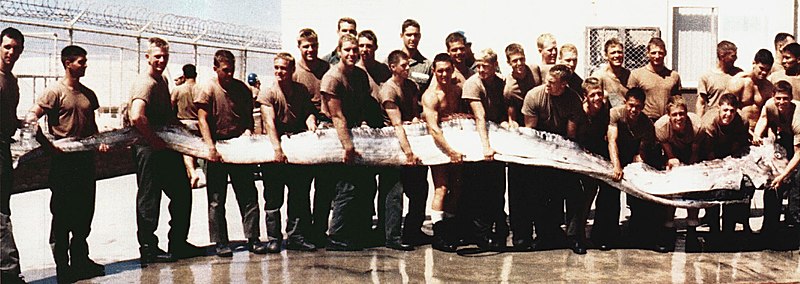Is Chile still there? Yes. Whew!
Earlier this summer no shortage of folks were predicting doom for the South American nation. And all because a group of fishermen showed up at the dock with a huge and scary-looking critter that, legend has it, portends the arrival of devastating tidal waves.
As a viral video of the catch of a 16-foot oarfish made off Chile racked up millions of views, the prognostications of trouble ahead also compounded. “Better leave that country for a while,” said one YouTube commenter, who was clearly not trying to be funny.
An Unusual Creature
The giant oarfish is long, slender and, well, shaped a lot like an oar. It’s mesopelagic, meaning it normally lives at intermediate sea depths between 650 and 3300 feet.
“A lot of deepwater fish will surface at night,” said Dr. Misty Paig-Tran, an associate professor at Cal-State Fullerton who studies oarfish, among other sea creatures. “They come up and go back down. But oarfish are not really doing that. They pretty much stay in that twilight zone.”
Sea Serpents
Which is why when oarfish do show up they tend to cause a stir. It’s thought that many of the “sea serpents” spotted by ancient mariners were actually oarfish. Where once these tales were shared by seasoned sailors tossing back grog and singing shanties about sea serpents, now the stories—complete with video, of course—are spread by social media.
Silvery with bright red fins, including a body-length dorsal, oarfish do cut an imposing jib, especially considering that they can reach tremendous size.

A 56-foot-long “sea serpent” found in the early 1800s on the isle of Stronsay (spelled Stronsa at the time), in Orkney, an archipelago off Scotland, was probably a giant oarfish.
Among the many unusual characteristics of the oarfish, one is that it can slough off its tail, not unlike lizards. Basically, everything aft of the vent is expendable. The tail doesn’t regenerate.
Because they so closely resemble eels, oarfish were thought originally to swim with a similar serpentine motion.
“They can do that snake-like undulation like other elongate fish do,” Paig-Tran said. “But they don’t sustain movement that way.”
Now that the fish have been recorded in their natural environment (primarily by deep submersibles), we know that they actually hold themselves vertically, head up, in the water column. Beating that body-length dorsal fin helps them maintain that position without sinking to the bottom.
“You can imagine, if you’re kind of just beating your dorsal fin and you have this enormous, 600-pound body, you’re not going anywhere fast and far,” Paig-Tran said. “If they need to go somewhere else, that’s when they likely briefly use that eel-like, anguilliform locomotion.”
Big Body, Tiny Food

So what kind of bait or lure does it take to trick an oarfish? Well, here’s the thing. With a small, toothless mouth, they are actually primarily filter feeders. The unusually-shaped fish uses their long, spiny gill rakers to capture tiny food such as euphausiids, small, shrimp-like crustaceans that are often called krill.
Paig-Tran has studied the stomach contents of collected fish.
“When we open them up they’re just filled with krill,” Paig-Tran said.
Details about the oarfish brought in off Chile are scant. But if the catch was made with a hook and line, it was almost certainly a lucky accident.
Or would that be an unlucky accident?
Shrouded in Superstition
The myth of the oarfish’s ability to predict disasters gained some momentum relatively recently, when it was said that the fish were seen near the surface shortly before the massive 2011 tsunami in Japan that caused the Fukashima nuclear disaster. There are other instances where oarfish have shown up around the same time as earthquakes and/or tidal waves.
Paig-Tran said the theory might actually have merit.
“The early seismic activity, when the earth creates that quake and releases pressure, it also can create an eddy that rises to the surface,” she said. “So, when an oarfish gets caught in the eddy, it brings them to the surface.”
And, because they are such weak swimmers, they can’t simply turn around and swim quickly back home.
Paig-Tran has personal experience with this.
“In 2013, we had some really unusual swells and eddies” off California, she said. “We actually collected three oarfish during that brief time.”
Fish and animals have long been stars of superstition, behavior that dates back to a time before science was able to provide factual explanations for things that happened.
Black cats, for example, have been considered a sign of impending bad luck. Doves are symbols of peace. And lord help the hunter who kills an albino whitetail—an action still considered by some a harbinger of certain sooner-than-later tragedy for the hunter.
As for Chile, there have been a few small seismic events this summer. But there haven’t been any tidal waves.
Yet.
Editor’s Note: Got an interesting catch? We’d love to hear about it! Drop us a line with all the details at catches@saltwatersportsman.com.









